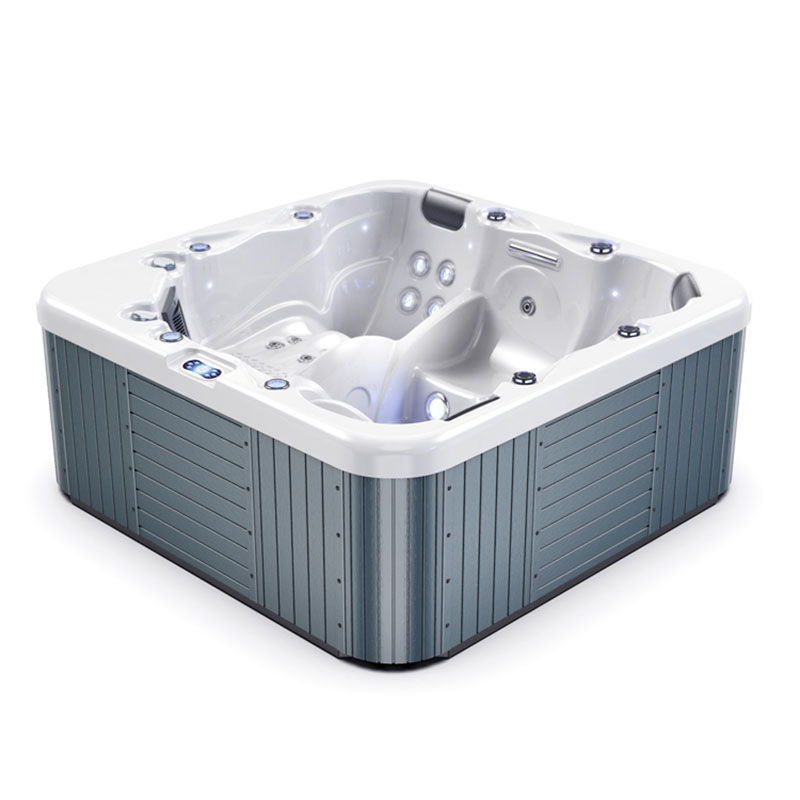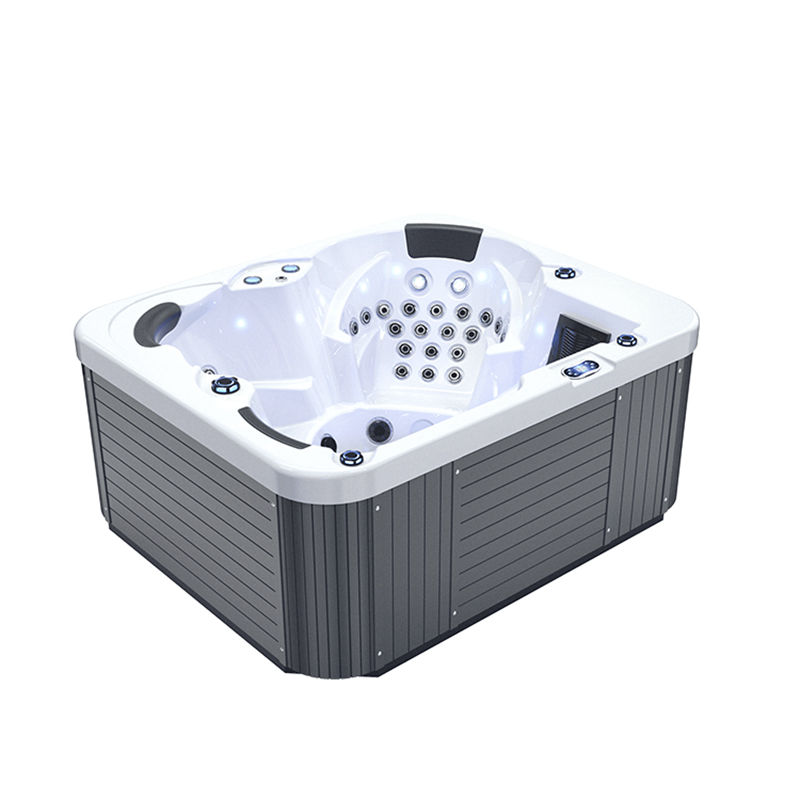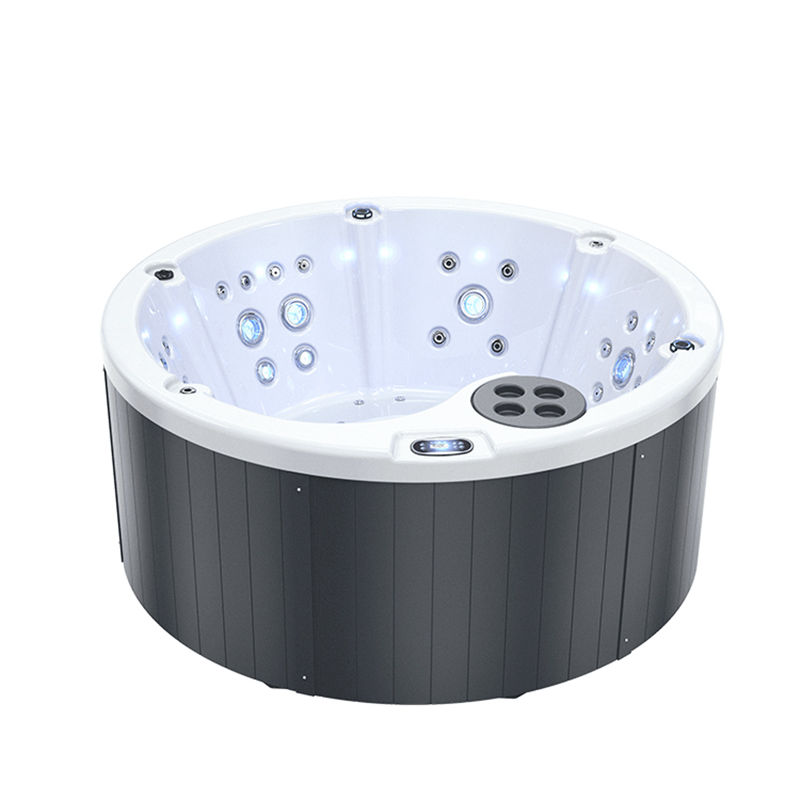Modern families are increasingly prioritizing a healthy and relaxing lifestyle. Swim spa tubs, with their combined exercise and hydrotherapy features, have become a standard feature in high-end homes. They not only provide a space for aerobic exercise, but also deliver full-body therapeutic massage through water flow and bubbles.
However, many users often wonder during routine maintenance: Can swim spa tubs be cleaned with bath soap?
This seemingly simple question involves a wide range of knowledge, including chemical reactions, water quality balance, and equipment structure.
This article will provide a detailed, professional analysis of this issue, helping you understand the impact of bath soap on swim spa tubs, proper cleaning methods, and key safety maintenance tips.
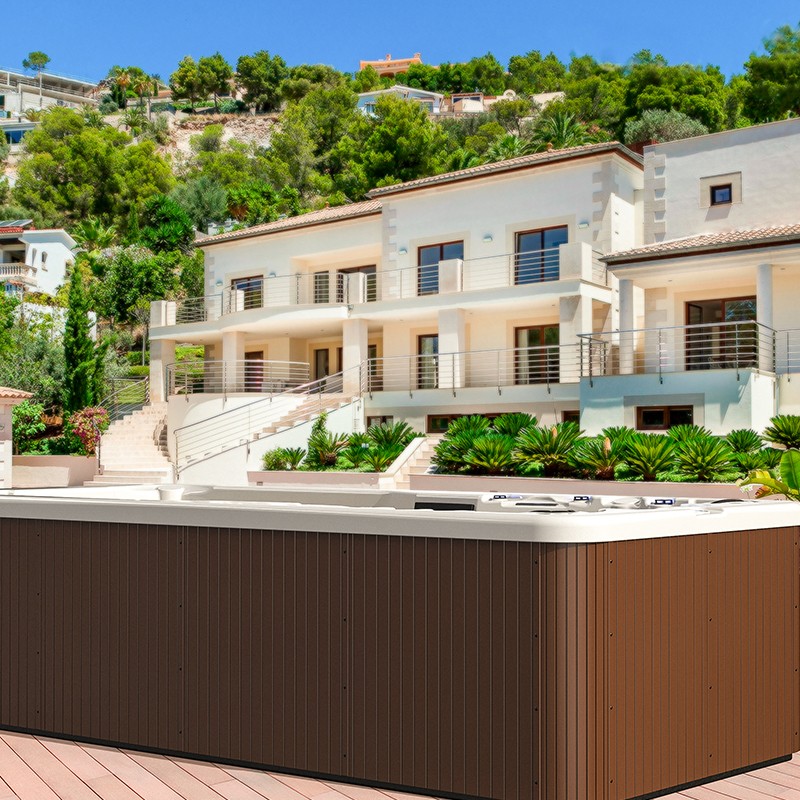
Why would someone want to use bath soap to clean a swim spa tub?
Many people use bath soap to clean bathtubs, tiles, or showers for a variety of reasons:
• Bath soap lathers easily and appears to have strong cleaning power;
• It has a fresh scent, creating a "clean" feeling after use;
• It's readily available and convenient to use.
Therefore, some users naturally apply the same cleaning methods to their swim spa tubs.
However, unlike ordinary bathtubs, swim spa tubs are more complex, containing circulation pumps, heating systems, nozzle systems, filtration systems, and water balance systems. These components are very sensitive to chemical composition.
This means that not all cleaners are suitable for swim spa tubs.
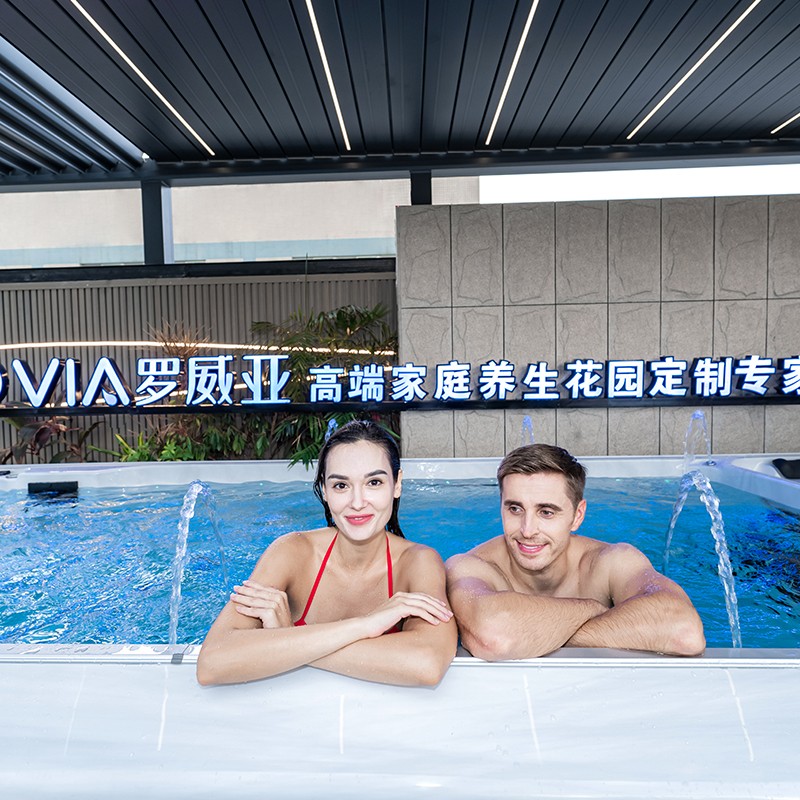
How do the ingredients in bath soap affect swim spa tubs?
To answer the question of "can it be used?", we first need to understand the chemical composition of bath soap.
Most bath soaps contain the following ingredients:
• Surfactants (such as SLES and SLS): Remove oil and dirt;
• Fragrances and colorants: Provide scent and color;
• Humectants (such as glycerin and propylene glycol): Moisturize the skin;
• Emulsifiers and preservatives: Maintain stability and prevent deterioration.
While these ingredients are gentle on the skin, they can pose potential hazards to the pipes and systems of a swim spa tub.
1. Excessive foam affects the circulation system
Swim spa tubs rely on powerful pumps and nozzles to circulate water. Using foaming bath soaps can quickly whip the foam into a large number of bubbles, causing:
• Filter clogging;
• Air in the pump, causing air blockage;
• Foam overflowing the tub, making it difficult to remove.
2. Chemical residue disrupts the water balance
Bath soaps contain organic matter and fragrances, which react with the chlorine or bromine in the spa system, reducing disinfection effectiveness. This not only causes water turbidity and odor, but can also breed bacteria.
3. Residual oil and grease form a film
Moisturizing ingredients and oily substances in bath soaps can adhere to the water surface and tubing walls, forming a film that reduces nozzle flow and heating efficiency.
4. Long-term corrosion of equipment materials
Some bath soaps have acidic or alkaline pH values, which can corrode stainless steel nozzles, rubber seals, and acrylic tubs.
In summary, bath soaps are not safe cleaners for swim spa tubs. While it may temporarily create a "clean" feeling, it can leave hidden dangers within the system that are difficult to remove.
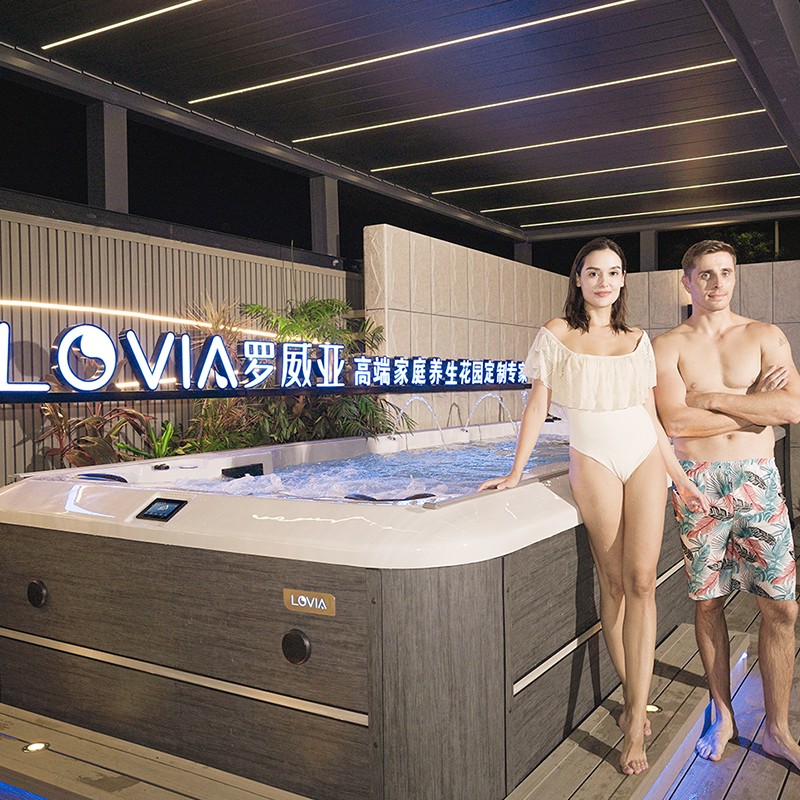
Why do you need a dedicated swim spa cleaner?
1. Specialized cleaners are safer in their formulations
Specialized swim spa cleaners typically maintain a neutral or slightly alkaline pH, effectively removing scale, grease, and biofilm without damaging the material.
2. They break down contaminants within pipes
Unlike ordinary bath soaps, specialized cleaners contain targeted active ingredients that penetrate the circulation lines and break down accumulated organic residue.
3. Compatible with filtration and heating systems
Specialized products have been tested to ensure they do not affect filter performance or form deposits on heating elements.
4. Reduce maintenance frequency
Regular cleaning with a specialized cleaner can extend the life of the equipment and reduce future repair costs.
Therefore, from a scientific maintenance perspective, choosing a dedicated swim spa cleaner is the only correct approach.
What should I do if I misuse bath soap?
Many users unknowingly use bath soap, resulting in cloudy or excessive foaming water. If this happens, take the following immediate steps:
• Turn off the spa system to prevent further agitation of the foam;
• Completely drain the water, including any remaining water in the pipes and pump;
• Refill the system with water and add pipe cleaner, allowing the system to circulate for 10-15 minutes;
• Drain the water again to ensure that any remaining bathing solution is completely rinsed out;
• Clean the filter and replace it with a new filter cartridge if necessary;
• Refill the system with water and adjust the water quality (pH, chlorine content, hardness, etc.).
Do not simply "remove the foam" or "add more disinfectant" to mask the problem; this will only complicate the chemical reaction.
What is the standard procedure for properly cleaning a swim spa tub?
To keep your swim spa clean and the system running smoothly for a long time, it should be cleaned and maintained regularly.
The following is a recommended procedure:
1. Drain the old water
Before shutting down or changing the water, drain the old water completely.
2. Use pipe cleaner
Pour an appropriate amount of spa system pipe cleaner into the water, run the system for about 15 minutes, and remove any internal deposits.
3. Clean the tub and nozzles
Scrub the tub, handrails, and nozzle area with a non-foaming spa cleaning solution.
Avoid using detergents containing surfactants.
4. Clean the filter
Remove the filter, rinse it with clean water, and then soak it in filter cleaner to remove grease and impurities.
5. Rinse and refill with water
Throughly rinse all surfaces and pipes with clean water before refilling with fresh water.
6. Adjust water quality
Use a pH adjuster and disinfectant to maintain optimal water quality (pH 7.2-7.8, residual chlorine 1-3 ppm).
This process ensures that your swim spa tub is clean, safe, and free of chemical residues.
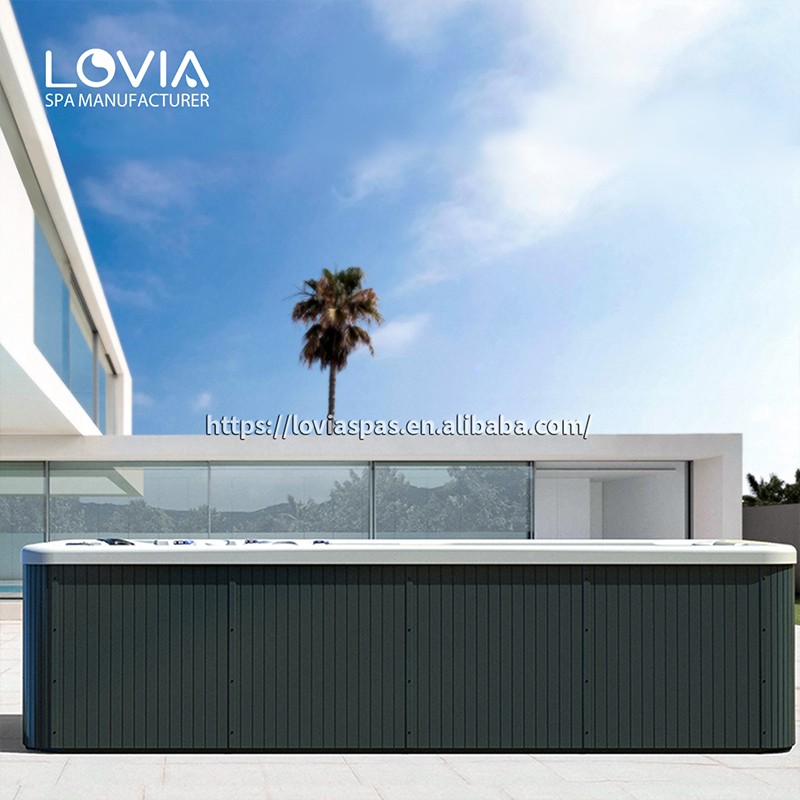
Why is maintaining water quality in your swim spa so important?
Many users mistakenly believe that clear water is clean. In reality, balanced water quality is far more critical than simply looking clean.
1. Water quality affects human health
Bacterial growth or an imbalanced pH in the water can easily cause itchy skin, eye irritation, and even respiratory discomfort.
2. Water quality affects equipment performance
Excessive organic matter and chemical residues in the water can reduce heating efficiency and clog nozzles.
3. Water quality affects maintenance costs
Good water quality can extend replacement cycles, reduce cleaning times, and save maintenance costs.
Thus, prioritizing both water quality management and cleaning is the core principle of proper swim spa operation.
What cleaning errors should be avoided?
To prevent equipment damage or safety issues, the following practices must be avoided:
❌ Using bath soap, laundry detergent, or dishwashing liquid for cleaning;
❌ Using household cleaners containing bleach;
❌ Using steel wool or a rough cleaning cloth to clean the tub;
❌ Using undiluted acidic descaling solution;
❌ Mixing multiple chemical cleaning agents simultaneously;
❌ Adding cleaning agents directly while the system is running.
While these practices may work in the short term, they can seriously damage the surface material and internal systems of your swim spa tub.
How to develop a regular cleaning and maintenance plan?
Maintaining the long-term cleanliness of your swim spa tub requires a scientific maintenance cycle.
Projects | Recommended frequency | Instructions |
| Surface Cleaning | Once a week | Wipe the inside and outside of the tank with a neutral, non-foaming detergent |
Filter Cleaning | Once every 2 weeks | Remove impurities from the filter and allow it to dry |
| Pipe Cleaning | Once every 2 months | Run the system through the cleaning cycle using a dedicated cleaning agent |
| Water Change | Once every 2-3 months | Drain the old water and readjust the water quality |
| pH Testing | Before each use | Ensure the pH is between 7.2 and 7.8 |
Adhering to this cycle will maintain optimal performance and hygiene.
Swim spa tubs should never be cleaned with bath soap
The above analysis leads to clear conclusions:
• Bath soap is not suitable for swim spa tubs;
• It can cause serious problems such as foam accumulation, water imbalance, and equipment corrosion;
• The correct approach is to use specialized non-foaming detergents and pipe cleaning fluids, along with scientific water quality management.
While enjoying the comfort of swimming and spa treatments, don't overlook the underlying maintenance science.
Only with proper care can your swim spa tub continue to provide you with a safe, clean, and healthy relaxation experience.
What makes LOVIA SPA a top spa manufacturer?
LOVIA SPA has over 30 years of experience as a manufacturer and supplier of high-quality outdoor and swim spas. Entering the international market in 2004, we became one of China’s top 5 spa brands. Our factory ensures precision manufacturing using Aristech acrylic, Balboa pumps, and LX electrical systems.
Buyers can purchase spas at competitive prices, take advantage of bulk discounts, and request customized designs. LOVIA SPA products are CE, ETL, SAA, ROHS, REACH, and ISO9001 certified, guaranteeing long-lasting performance.


